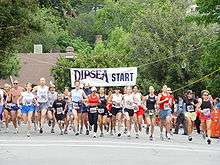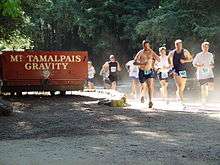Dipsea Race
| Dipsea Race | |
|---|---|
 <-- Stinson Beach -- Muir Woods -- Mill Valley --> | |
| Date | Second Sunday in June |
| Location | Marin County, California, USA |
| Event type | trail |
| Distance | 7.5 mile (12 km) |
| Established | November 19, 1905[1] |
| Course records |
|
| Official site | http://www.dipsea.org/ |
The Dipsea Race is a trail running event in California, United States. It is the oldest cross-country trail running event and one of the oldest foot races of any kind—in the United States. The 7.5 mile (12 km) long Dipsea Race has been held annually almost every year since 1905, starting in Mill Valley, and finishing at Stinson Beach, in Marin County. The Dipsea celebrated its 106th running on Sunday, June 12th, 2016. Since 1983, the race has been held on the second Sunday in June.
Course

The Dipsea is well known for its scenic course and challenging trails. The race starts on Throckmorton Avenue in Mill Valley, near Miller Avenue, in front of the old train depot (now a bookstore). After traversing a few blocks in Mill Valley's downtown, runners climb 688 stairs[4] leading up the side of Mount Tamalpais, and then pass through Muir Woods National Monument, Mount Tamalpais State Park, and the Golden Gate National Recreation Area. The Dipsea Trail is the most direct route connecting the town of Mill Valley, located near the northwestern shores of Richardson Bay, with the village of Stinson Beach, situated along the Pacific coast. Stinson Beach is a popular tourist destination, located about a 30-minute drive north of San Francisco on Highway 1, via the Golden Gate Bridge. The ascent over the southern shoulder of Mount Tam reaches its apex around the top of Cardiac Hill, about 4.5 miles into the race.
Among the challenges facing participants are the Dipsea Trail's uneven footing, single-track footpaths, and almost invariably steep terrain, featuring about 2,200-foot (671 m) elevation gain and loss over the course. The uniqueness of the Dipsea Race course owes largely to the opportunity for competitors to choose from any of several alternate routes on diverging and converging trails, adding a competitive premium for strategy, experience, and familiarity with the course.
Course mileage

| Location | Segment distance | Distance total |
|---|---|---|
| Old Mill Park | 0.2 | 0.2 |
| Bay View Drive @ Panoramic Highway | 0.9 | 1.1 |
| Muir Woods Parking Lot | 1.0 | 2.1 |
| Cardiac Hill | 2.3 | 4.4 |
| Bridge at Steep Ravine | 1.6 | 6 |
| Stinson Beach | 1.5 | 7.5 |
Race details and champions
The Dipsea's handicapping system often produces younger or older winners, which adds to the unusual intrigue and suspense created by the race's permissible shortcuts, like 'Suicide' and 'The Swoop'. Most participants, with the exception of 'scratch' runners, are given a head start based on their age and gender. The oldest and youngest runners are given up to a 25-minute advantage over the fastest competitors, making it possible for virtually any age group to produce a race winner; previous winners include children as young as 8, and men and women as old as 72.[5]

Because of the nature of the course, the field of competitors is limited to 1,500. It is a popular race, and thousands of people apply for entry every year. This makes it difficult for people, particularly those who have never run it before, to get accepted into the race.
As of June 2016, the defending champion is 58-year-old Brian Pilcher, who also won in 2009 and 2015.[6] The previous eight champions are Diana Fitzpatrick (2013, 2014), Hans Schmid (2012), Jamie Rivers (2007, 2011), Reilly Johnson (age 8, 2010), Roy Rivers (2008), Melody-Anne Schultz (1999, 2003, 2006) Russ Kiernan (1998, 2002, 2005), and Sal Vasquez (1982-1985, 1990, 1994, 1997).
Jack Kirk, known as the 'Dipsea Demon', holds the record of most consecutive competitions in the Dipsea, having finished 67 consecutive Dipseas from 1930 until 2002. (There was no official Dipsea Race in 1932 or 1933, due to economic reasons, nor in 1942–1945 due to World War II.) Kirk finished his last complete race in 2002. He started but did not finish in 2003, but did reach the highest elevation, at the top of "Cardiac Hill," at the age of 96. He is the oldest person to have competed in the race. Kirk died on January 29, 2007, at age 100.[2] Jack's story was documented in the 2004 film "The Dipsea Demon"[7]
Other races on the Dipsea Trail
Two other races use the same course route: the Double Dipsea, held in late June, and the Quad Dipsea, an ultramarathon, which takes place in late November. Despite the use of the Dipsea name, these two races are not officially affiliated with the Dipsea Race.
Double Dipsea
The Double Dipsea is a 13.7-mile (22 km) run held on the Saturday thirteen days after the Dipsea. Now organized by the Dolphin South End Running Club, San Francisco icon Walt Stack put together the first Double Dipsea race in 1970.[8]
Quad Dipsea
The Quad Dipsea is a 28.4-mile (45.7 km) trail ultra, held annually in November on the Saturday following Thanksgiving. The Quad starts and finishes in Mill Valley, following the Dipsea Trail westward to Stinson Beach, out-and-back twice over the same course as the Dipsea Race and the Double Dipsea. The race has 9,276 feet (2,827 m) of both climb and descent. First held in 1983 with only 8 runners, the race is now limited to about 250 runners.[9]
In popular culture
The 1986 movie On the Edge, without using the name "Dipsea", revolves around a race that is unmistakably the Dipsea Race.[10][11] It stars Bruce Dern as a runner obsessed with the race.
See also
Notes
- 1 2 Pacific Sun, June 3, 2005, "All Hail the Dipsea!", accessed August 18, 2007
- 1 2 Dipsea.org, The Dipsea Race. "Dipsea Demon Passes to 672nd Step", accessed August 18, 2007
- 1 2 Dave Albee, Marin Independent Journal, June 6, 2007, "The Dipsea Race: Whatever happened to Sal Vasquez?", accessed August 18, 2007
- ↑ Dave Stienstra, San Francisco Chronicle, June 12, 2010, "Dipsea Race, now 100, is a storied run westward"
- ↑ Tamalpa Dipsea History
- ↑ "Kentfield's Pilcher wins second straight Dipsea Race". www.marinij.com. Retrieved 2016-06-14.
- ↑ Filmbaby review
- ↑ The Double Dipsea. Tamalpa Runners (2004-06-26). Retrieved on 2013-07-21.
- ↑ Quad Dipsea
- ↑ On the Edge at IMDB
- ↑ Tamalpa Runners History
External links
| Wikimedia Commons has media related to Dipsea Race. |
- Dipsea.org – Official website
- DoubleDipsea.com – Double Dipsea Official website
- MarinIJ.com – Dipsea Race news portal, Marin Independent Journal
- Run100s.com – Quad Dipsea Official website
- QuadDipsea.com – Quad Dipsea website
- TamalpaRunners.org – Tamalpa Runners
- Runtrails.blogspot.com – Quad Dipsea Race Report (w/pictures)